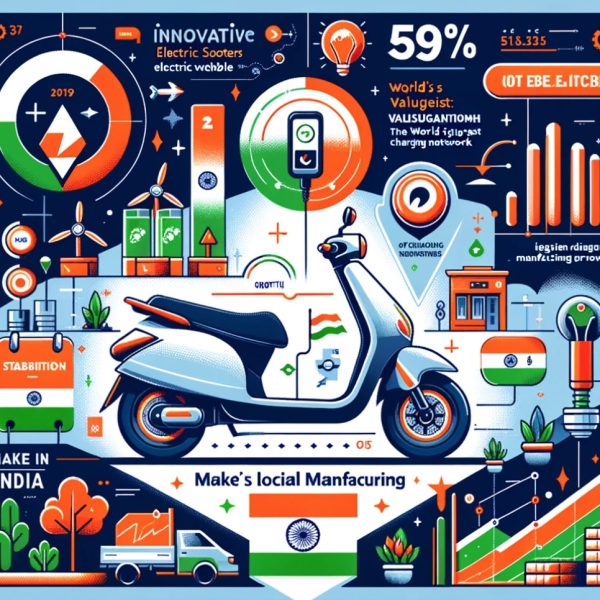Ola Electric: Accelerating India’s EV Revolution with Unmatched Innovation and Scale
August 23, 2025
Industry: Electric Vehicle

In 2025, Ola Electric remains a dominant EV player but faces pressure—revenue dropped from ₹5,010 crore in 2024 to ₹4,514 crore in 2025, and losses widened to ₹2,276 crore. Despite market share decline—from nearly 50% to 20%—new models, battery innovation, and expanded service reach keep Ola in the fast lane.
1. Market Landscape & Ola’s Role in India’s EV Revolution
India’s EV industry has become one of the fastest-growing segments of its automotive market. With rising fuel costs, government incentives, and consumer demand for greener mobility, EV penetration in the two-wheeler segment is accelerating. Ola Electric, founded in 2017 by Bhavish Aggarwal, quickly established itself as the face of India’s EV revolution—capturing early consumer mindshare with its S1 scooter series and building the largest EV manufacturing plant in the country.
2. Financial Performance & IPO Journey
- In FY24, Ola Electric reported revenue of approximately ₹5,010 crore, but net loss was ₹1,584 crore.
- In FY25, revenue dropped to ₹4,514 crore while net loss expanded to ₹2,276 crore.
- Ola went public in August 2024, raising ₹5,500 crore in its IPO. Initially valued highly, the stock fell by more than 40% in 2025 amid concerns about losses and market share erosion.
- Despite near-term struggles, Ola continues to attract attention for its long-term growth potential, backed by ambitious infrastructure and product strategies.
3. Market Share and Competition
Ola Electric once held 30–50% of India’s EV two-wheeler market, but by mid-2025 its share dropped to about 20%, as rivals Ather Energy, TVS, Hero, and Bajaj ramped up production.
To counter competitive pressure, Ola unveiled its “India Inside” vision, showcasing locally made 4680 Bharat Cell batteries, rare-earth-free motors, and AI-driven vehicles. It also announced plans to launch 12 new two-wheelers across categories, including premium sports scooters, to re-capture growth.
4. Innovation & Battery Independence
Battery innovation is central to Ola’s strategy:
- 4680 Bharat Cell: Ola is developing its own lithium-ion cells, produced at its Gigafactory, to cut reliance on imports and improve unit economics.
- Solid-State Batteries: The company has invested heavily in solid-state R&D, aiming for safer batteries with faster charging and longer ranges.
- Vertical Integration: By controlling battery production, Ola hopes to stabilize costs, increase margins, and offer differentiated EVs.
5. Distribution Network & After-Sales Strategy
Service and distribution have been Ola’s weak points, with customers often complaining about delays and lack of support. To address this, Ola has expanded:
- Sales footprint: From around 800 stores to a target of 10,000 partners by end-2025.
- Service centers: Over 430 centers currently, expanding aggressively to strengthen consumer trust.
- Digital ecosystem: MoveOS, Ola’s proprietary software, integrates features like AI assistants (powered by Krutrim), predictive maintenance, and over-the-air updates.
6. Product Portfolio & Expansion
Ola Electric is no longer just a scooter company—it is becoming a multi-segment EV player:
| Segment | Ola Electric’s Positioning (2025) |
|---|---|
| Scooters | S1 family including S1 Air, S1 X, and S1 Pro, covering entry-level to premium |
| Motorcycles | Roadster X and X+, priced between ₹1–2 lakh, entering the mass motorcycle market |
| Sports Scooters | Launching advanced AI-powered sports scooter to compete with TVS and Yamaha |
| Battery Tech | In-house 4680 Bharat Cell + solid-state R&D for future vehicles |
| Software | MoveOS 6, integrated with Krutrim’s AI assistant features |
This portfolio diversification is designed to reduce reliance on a single category and expand Ola’s reach across the mobility spectrum.
7. Value Investing Perspective
Strengths
- Strong brand recognition and early-mover advantage.
- Vertical integration with Gigafactory and battery innovation.
- Ambitious R&D in solid-state technology.
- Aggressive expansion into new vehicle categories.
Risks
- Declining market share amidst rising competition.
- Structural losses and high capital expenditure.
- Execution risks in scaling service networks and delivering on battery promises.
Investor Outlook
Ola Electric is a high-risk, high-reward stock. It represents India’s boldest EV play, but profitability will depend on execution—particularly in manufacturing batteries at scale, competing on costs, and improving customer trust.
8. Future Roadmap (2025–2030)
- Profitability Drive: Ola aims to achieve break-even by leveraging in-house batteries and improved unit economics.
- Global Aspirations: Exploring exports to emerging markets in Southeast Asia and Africa.
- Ecosystem Growth: Building a mobility super-app that integrates EV sales, ride-hailing, financing, and service.
- Sustainability Goals: Commitment to renewable-powered plants and recycling of used EV batteries.
9. Conclusion
Ola Electric remains a flagbearer for India’s EV industry. While it faces challenges—shrinking market share, widening losses, and stock volatility—it also leads in ambition, scale, and innovation. Its India Inside strategy, battery independence, and diversification into multiple vehicle categories will determine if it can stay ahead in India’s EV race.
For investors, Ola Electric offers exposure to India’s clean mobility future. But caution is warranted: it is still an evolving story, with execution risks as large as the opportunities it chases.








